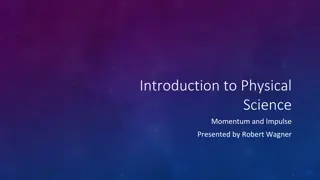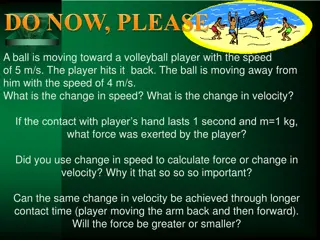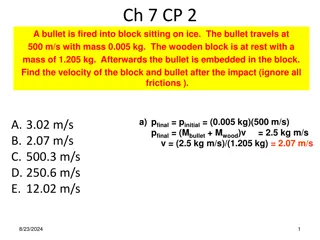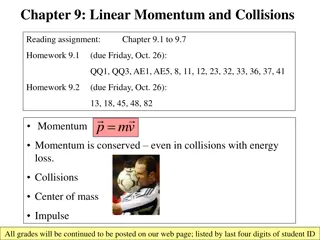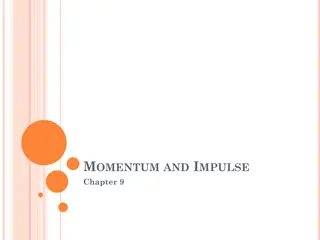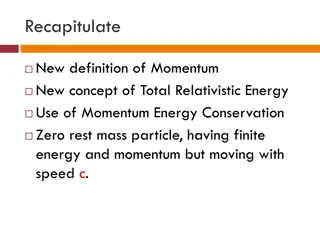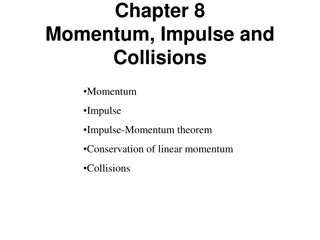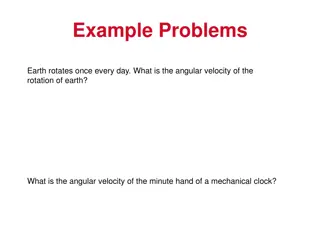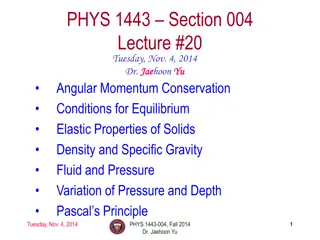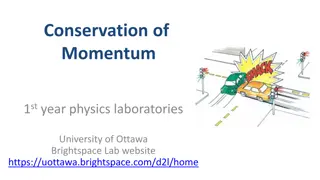Understanding Conservation of Momentum in Physics
Conservation of momentum in physics addresses how the total momentum of a system remains constant in a collision or interaction between objects. Newton's Third Law and the law of conservation of momentum play key roles in explaining the transfer of momentum between objects during collisions. Momentum, being a vector quantity, must be conserved in both magnitude and direction, making it a fundamental concept in analyzing the motion of objects in various scenarios.
Download Presentation

Please find below an Image/Link to download the presentation.
The content on the website is provided AS IS for your information and personal use only. It may not be sold, licensed, or shared on other websites without obtaining consent from the author. Download presentation by click this link. If you encounter any issues during the download, it is possible that the publisher has removed the file from their server.
E N D
Presentation Transcript
Conservation of Momentum (1D) Pg. 228- 232
Momentum When the cue ball hits the eight ball in billiards, the eight ball hits the cue ball When a rock hits the ground, the ground hits the rock In any collision, two objects exert forces on each other You can learn more about momentum by analyzing the motion of both objects in a collision
Newtons Third Law & Momentum Unlike Newton s second law, which focuses on the motion of one specific object, his third law deals with the interaction between two objects When you apply Newton s third law to collisions, you discover one of the most important laws of physics the law of conservation of momentum
Newtons Third Law & Momentum This equation summarizes the law of conservation of momentum for two or more colliding objects:
Newtons Third Law & Momentum Take note: Since momentum is a vector quantity, both the magnitude and the direction of the momentum must be conserved Therefore, momentum is conserved in each dimension, independently
Law of Conservation of Momentum When two or more objects collide, the collision does not change the total momentum of the two objects. Whatever momentum is lost by one object in the collision is gained by the other. The total momentum of the system is conserved. Note: Two general categories of interactions exist: collisions and explosions (or recoil) Regardless of the category, momentum is always conserved, whether the objects bound off one another, stick together, or break apart
note Law of Conservation of Momentum When two or more objects collide, whatever momentum is lost by one object is gained by the other (momentum is conserved)
Did you know? In reality, systems are rarely perfectly isolated In nearly all real situations, immediately after collision, frictional forces and interactions with other objects change the momentum of the objects involved in the collision Therefore, it might appear that the law of conservation of momentum is not very useful However, the law always applies to a system from the instant before to the instant after collision Therefore, if you know the conditions just before a collision, you can always use the conservation of momentum to determine the momentum and , thus, velocity of the object at the instant after a collision Often, these values are all that you need to know
Conservation of Momentum (1D) Take note: In one-dimensional collisions, each vector can point in only one of two ways Designate directions in a way that is convenient for solving a particular problem For example, you may choose to assign right as positive and left as negative Then you can express vectors using only their magnitudes, understanding that a negative value implies a left direction
Practice 1. A 1750 kg boxcar is rolling down a track toward a stationary 2000 kg boxcar as shown. When the boxcars collide, they lock together and continue down the track. What is the velocity of the two boxcars immediately after the collision? (hint: they will have the same final velocity since they lock together) 2. The two objects shown collide head-on. If the 7.5 kg object has a velocity of ~4.5 m/s after the collision, what velocity does the 2. 5 kg object have after the collision?
Practice 3. A 1400 kg cannon (including the 50 kg ball) is on wheels. The cannon fires the cannon ball, giving it a velocity of 50 m/s[N]. What is the initial velocity of the cannon the instant after it fires the cannon ball? 4. Two objects of masses m and 3m undergo a collision in one dimension. The lighter object is moving at three times the speed of the heaver object. Describe what happens to their speeds after the collision. Explain your reasoning. Textbook: pg. 232, #2 - 5


